FREE RESOURCE: Downloadable Poker Cheat Sheets
Level Up Your Game with FREE Poker Cheat Sheets!
Improve your game quickly and get Jonathan's best tips for tournaments and cash games
WHAT YOU'LL GET:
Tournament Cheat Sheet
Cash Game Cheat Sheet
- 43 of Jonathan Little's BEST Tournament Tips
- 6 things you should focus on BEFORE a tournament
- 11 things you should focus on DURING a tournament
- 6 things you should focus on AFTER a tournament
- 42 of Jonathan Little's BEST Cash Game Tips
- 5 things you should focus on BEFORE every session
- 4 things you should focus on DURING each hand
- 7 things you should focus on AFTER every session
- Additional FREE resources for further learning
Poker Cheat Sheets – Level Up Your Game At Once
Poker is a complex game with many nuances, but our poker cheat sheets are designed to help you quickly and effectively rectify your biggest mistakes.
Our downloadable tournament and cash game sheets will teach you what areas of the game you should focus on to improve your results as quickly as possible.
Choose the right poker cheat sheet for yourself and study it before your sessions for the best results and fastest progress.
Poker Hands Cheat Sheet – Know the Basics
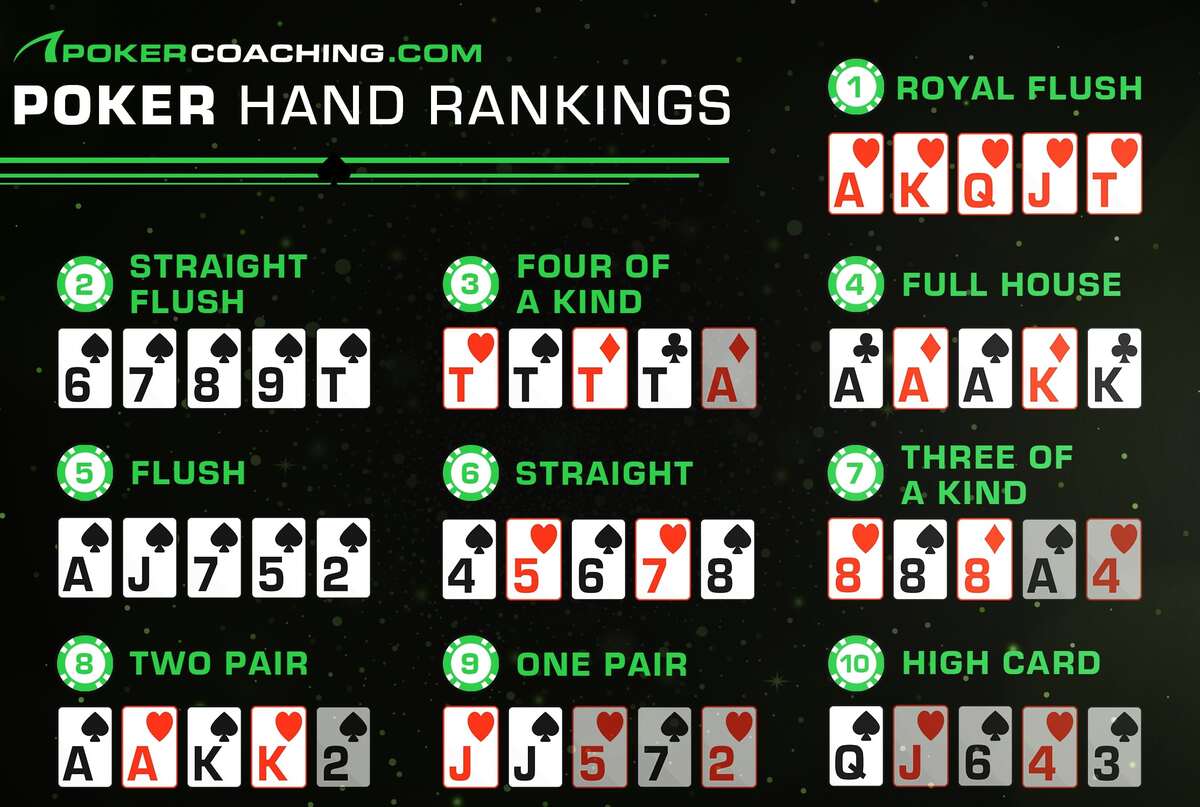
Before you can start playing poker, you must know what beat what in poker and how various hands rank in the game. In Texas Hold’em, hands are ranked from a royal flush as the best hand to a high card hand as the worst.
While you can win a hand of poker without showing down your cards, making the best hand will still be an essential part of the game.
For that reason, make sure to memorize the table below in full before you start playing or use it to brush up even if you already understand the basic poker hand rankings:
Poker Hand
Explaination
Example
1. Royal Flush
The five highest cards of the same suit
AcKcQcJcTc
JcTc9c8c7c
Any five consecutive cards of the same suit
Four cards of the same rank
4c4s4d4hJc
3c3s3d7h7c
4. Full House
Three cards of one rank + two cards of another rank
5. Flush
Five cards of the same suit
KdJd7d5d3d
6s5s4d3d2h
6. Straight
Five consecutive cards in different suits
Three cards of the same rank
7c7h7d2hJ2
QcQs2c2hJs
8. Two Pair
Two cards of one rank + two cards of another rank
9. One Pair
Two cards of the same rank
8h8sAcKs5d
10. High Card
Any other hand
AcQdJs4h3c
Poker Basics Explained
If you are just starting in poker, we highly recommend you memorize the table above and learn basic poker rules.
But before you do that, here is a quick crash course on poker basics!
The goal of the game is to win the hand by either having the best poker hand at the showdown or getting all other players to fold their cards.
Each Texas Hold’em hand starts with two players at the table posting obligatory bets called “blinds.” Once the small blind and the big blind are posted, all players get two hole cards and a chance to act on them.
Players take turns taking one of the following actions:
● Fold: Discard the hole cards and leave the hand.
● Call: Match the value of the big blind and stay in the hand.
● Raise: Increase the size of the bet to any desired amount.
Once all preflop betting is completed, the dealer deals three community cards in the middle of the table. These three cards are called the flop.
All players who are still active in the hand get to act once again. Two new actions are introduced on the flop:
● Check: Pass the action to the next player without making a bet.
● Bet: Make a bet of any size you choose if no bet has been made before you.
Once all flop betting is completed, the dealer puts out the next community card, called the turn. Once again, the remaining players act on their hands.
The final community card, the river, is placed on the table after turn betting. With all cards now dealt out, players take one last turn acting on their hands.
The dealer announces “showdown,” prompting the players to show their cards and reveal the winning hand.
The basic rules of Texas Hold’em may sound very simple, but its nuances make it one of the most complex strategic games in the world.
Texas Hold’em Cheat Sheet for Starting Hands
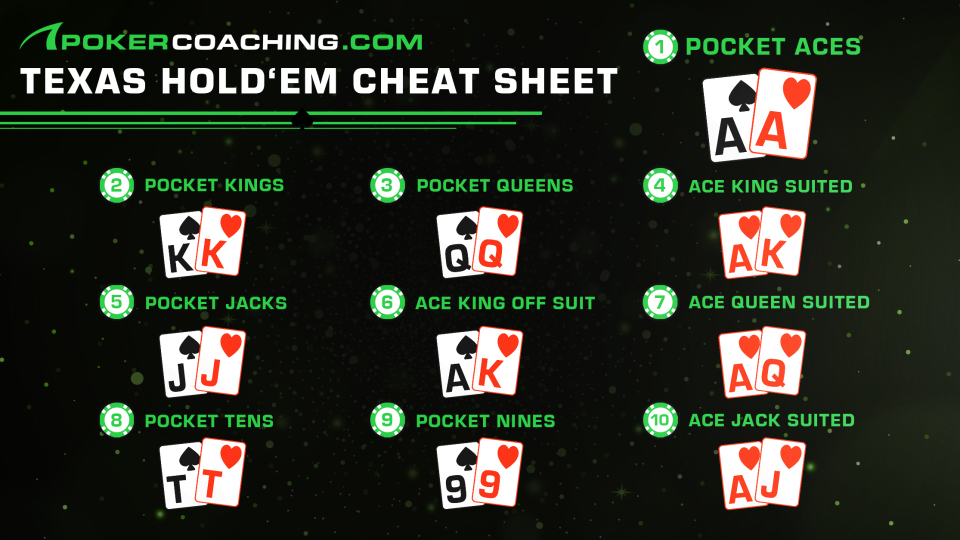
Some of the biggest poker mistakes are made with preflop hand selection, as many players are not sure which hands to play in different situations.
While the range of hands you should play changes significantly with stack size, position, and other factors, there are some hands you should play every time they are dealt to you.
The table below shows the top ten hands in Texas Hold’em Poker and their equity against some typical poker ranges.
The top ten starting hands in poker are favorites against even the tightest hand ranges and do exceptionally well against players who play a wider range of hands and get involved often.
Check out the table for a more detailed look into the equities of the ten best hands in Texas Hold’em against different poker ranges:
| vs. 10% | vs. 15% | vs. 25% | vs. 40% | |
|---|---|---|---|---|
| Pocket Aces (AA) | 84.10% | 84.31% | 84.37% | 84.62% |
| Pocket Kings (KK) | 73.73% | 74.21% | 76.92% | 77.43% |
| Pocket Queens (QQ) | 65.69% | 68.81% | 72.09% | 73.36% |
| Pocket Jacks (JJ) | 58.61% | 64.07% | 67.39% | 70.17% |
| Ace-King Suited (AKs) | 57.95% | 59.29% | 62.76% | 65.72% |
| Ace-King Offsuit (AKo) | 55.88% | 57.26% | 60.87% | 63.98% |
| Pocket Tens (TT) | 53.84% | 59.80% | 62.72% | 66.95% |
| Ace-Queen Suited (AQs) | 51.81% | 55.40% | 60.03% | 63.41% |
| Pocket Nines (99) | 49.75% | 55.79% | 58.09% | 62.72% |
| Ace-Jack Suited (AJs) | 45.36% | 51.03% | 57.47% | 61.66% |
P.S. – these numbers will vary a bit based on what particular hands you select in the actual range you are comparing the hand against, but this gives a good estimate of the equity you will have with the top 10 holdings.
Opening Ranges – What Hands You Should Play
While memorizing the top ten hands is not a difficult job, learning what hands to play in different positions and at different stack sizes takes a lot more work.
Fortunately, you won’t have to memorize each hand in each opening range, as there is an easier way to learn what hands are playable in different scenarios.
The opening range comprises all the hands you should be raising when you find yourself in a given scenario. For example, playing with 100 big blinds in a tournament, you should open about 10% of your hands from UTG.
The table below shows some of the most popular opening ranges for tournament poker. Our downloadable preflop poker charts provide more detailed information and a full recap of every opening range.
| UTG | UTG+1 | UTG+2 | LJ | HJ | CU | D | SB | |
|---|---|---|---|---|---|---|---|---|
| 100 BB RFI | 10.1% | 14.3% | 15.7% | 18.3% | 21.3% | 27% | 51.1% | 31% + 48.6% (Limp) |
| 75 BB RFI | 13.7% | 16.3% | 19.2% | 23.5% | 27.9% | 37.3% | 54.8% | 18.4% + 69.1% (Limp) |
| 40 BB RFI | 16.1% | 17.5% | 20.5% | 23.5% | 28.7% | 36.2% | 50.8% | 32.8% + 54.4% (Limp) |
| 25 BB RFI | 16.7% | 18.7% | 20.8% | 24.1% | 27.8% | 34.2% | 46.3% | 38.8% + 50.1% (Limp) |
| 15 BB RFI | 16.7% | 18.7% | 17.4% | 20.2% | 23.1% | 30% | 39.1% | 27.9% + 60.3% (Limp) |
Cheat Sheet for Poker Positions
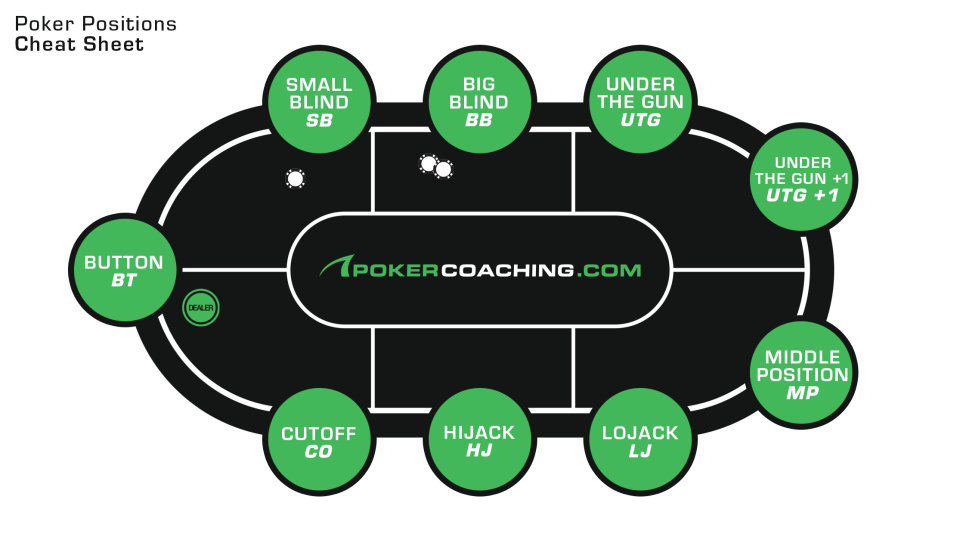
While sometimes neglected in the game, understanding poker positions is actually one of the most important parts of any poker strategy.
Your position at the table, relative to all the other players, will determine what hands you can play, how often you can steal the blinds, and how often you will meet resistance from another player.
Understanding the importance of position in poker is essential if you want to become a top poker player someday, and it all starts right here.
The next time you play poker, make sure to think about your position in every hand you play and try to stay in position as often as possible. Here are some useful tips about poker positions.
Under the Gun (UTG)
The first to act before the flop, you will have to play very tight from UTG. Depending on your stack size, it is recommended to play between 10% and 15% of all hands from this seat.
When you find yourself seated UTG, you should not be overthinking bluffing. Instead, focus on playing a solid range made up mainly of the best hands in Texas Hold’em.
To balance things out, you will want to add a few bluffing hands like A5s into your range, but playing against recreational players, you may even be able to avoid this and play a range that’s made up entirely of value hands.
When you face a 3-bet against your UTG raise, fold the weakest hands in your opening range and remember that the player 3-betting you is also aware you opened UTG but is still deciding to put in another raise, suggesting they have a strong hand.
Under the Gun +1 (UTG+1)
The next position at the poker table is very similar to UTG in all things. The opening range from UTG+1 is slightly wider, but you should still open at most 18% of all hands.
This is still a very strong range made up mostly of suited Aces, stronger pocket pairs, and premium poker hands, with very few pure bluffs in it.
If you open a hand from UTG+1, you will have to get through seven opponents, which means there is a decent chance of one of them holding a monster.
For that reason, continue opening a tight range, and fold most of your hands if the Under the Gun player comes in for a raise.
Under the Gun +2 (UTG+2)
UTG+2 allows you to open a bit wider than the two earlier positions but is still considered an early position, meaning you should still be playing very tight.
Depending on your stack size, you will be opening a maximum of 21% of your hands, and even this is a pretty wide range that you may want to shrink a bit until you feel more comfortable dealing with 3-bets.
Facing earlier position raises, you should usually fold everything but your best hands, as bluffing against the strong UTG and UTG+1 ranges and with six other players left to act is rarely a good decision.
Lojack (LJ)
Once again, you will expand your opening range a bit with two players folding in front of you, with some stack sizes allowing you to open up to 25% of all hands.
One-quarter of all poker hands will include more hands that can’t be considered premiums, such as suited connectors and one-gappers, but still very few offsuit hands and basically no trash hands.
Unlike your UTG range, however, your LJ range will be made up of quite a few hands that are not at the very top of the rankings, which means you will want to fold to 3-bets a bit more often.
Hijack (HJ)
Finally, getting into the later positions at the table, HJ is a position from which you can start opening a bit wider, stealing the blinds, and bullying the table.
Playing from HJ, you will have a decent chance of playing the pot in position against the big blind or picking up the blinds outright, so you can play close to 30% of all hands at middling stack depths.
Still, you don’t want to go too wild with your HJ raises, and you want to be very careful if faced with action from earlier positions, as it still suggests quite a bit of strength.
Cutoff (CO)
The Cutoff is one of the two late positions at the table, and while it does not guarantee an absolute position postflop, it is the next best thing after the Dealer.
Raising from the CU, you will only need to get rid of one player to ensure you are in position, and you can start to widen your 3-betting range.
Optimal opening ranges for CO allow you to raise as many as 38% of all hands at 75 big blinds, while your 3-betting ranges allow you to start 3-bet bluffing against LJ and HJ raises quite a bit.
The only real problem with playing from the CO is that the BTN will get involved some of the time and ruin your plans for the rest of the hand.
Dealer (BTN)
The Dealer is the best position at the poker table and one you should play the most hands from, whether we are talking about RFI, 3-betting, or calling raises.
Playing from the BTN, you will have a position on every player who decides to get involved on every street throughout the hand, guaranteeing you will over-realize your equity.
On the other hand, every other player who gets involved with you will under-realize their equity, as you will be able to control the game flow and size of the pot.
You want to play more hands from the BTN than any other position (except the blinds), and opening as many as 54% of all hands at deeper stack sizes is recommended.
You will also want to 3-bet more liberally than you would in any other position, as you will have a position in a 3-bet pot if anyone decides to call, which is a huge advantage.
Small Blind (SB)
The Small Blind is a unique position at the poker table, as the player in the SB already has money committed to the pot before the action starts.
For that reason, your strategy in the SB will include raises with a polarized range, made up of strong hands and complete bluffs, as well as limps with a wide range of middling hands.
The exact range you should play in the Small Blind depends on the game type you are playing, the presence of antes, and the stack depth.
Despite being out of position against all other players at the table, SB is a position you will play many hands from, as the discount you are getting is well worth getting involved.
Big Blind (BB)
Playing from the Big Blind is quite different from playing from other positions, as you will get to see many flops when facing min-raises and even see some flops for free playing against Small Blind limps.
The GTO poker strategy for Big Blind play dictates you should call a lot of raises, especially from later position players, with a wide range of hands.
The discount you are getting on calling and seeing a flop means you should not 3-bet bluff too often, but rather only 3-bet with your strongest hands and a few bluffs for balance.
Since you will be playing so many hands from the big blind, this position is worth studying quite a bit, as mastering your Big Blind play will significantly impact your bottom line.
Poker Tournament Cheat Sheet
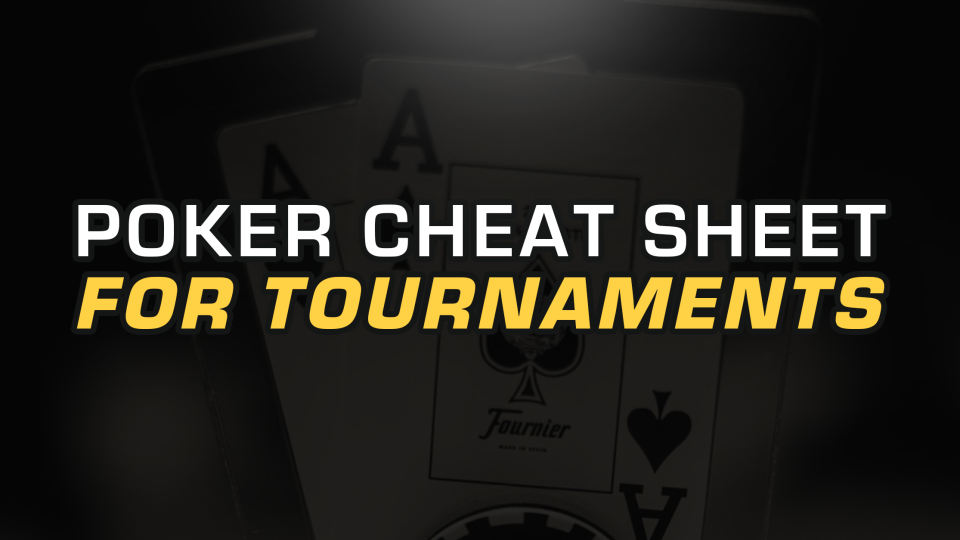
If you want to become a tournament poker crusher, you will need to develop a comprehensive skillset that allows you to win at different stack depths and through the various stages of poker tournaments.
You will need to learn how to play optimally, adjust to different opponents, and make exploitative plays at the right time.
Our tournament poker cheat sheet is designed to help you prepare for your tournament sessions and play your best game once you are seated at the tables.
The cheat sheet itself offers the most valuable advice in the shortest form possible, helping you make the right moves on the fly and quickly adapt in the right way.
Prepare Like the Pros
Professional poker players have a winner’s mentality, and they prepare for their sessions meticulously, doing a big chunk of their work away from the tables.
From bankroll management to mental preparation and a healthy lifestyle, the best poker pros leave nothing to chance.
Our tournament poker cheat sheet provides you with a detailed list of things you should focus on before your tournaments and go over before you start playing.
Go over the tournament preparation checklist before every session you play, and try to check as many boxes as possible each time you play.
Focus on the Game
Once you are playing a poker tournament, it should be the only thing that matters. All other concerns should be left for later.
If you want to become a profitable poker player, you must treat the game like a job and make sure that you are completely focused on the game when you are playing.
Stack sizes, player tendencies, payout structure, and ICM implications, are only some of the things you should be focusing on when playing tournament poker.
Our tournament poker cheat sheet will provide you with a detailed checklist of items you should be looking out for in your games.
Make sure to consult the sheet whenever you are playing to make sure you are not forgetting about a key element and allowing yourself to play on autopilot.
Never Stop Improving
The only way to greatness in poker is to always keep improving. To this end, you should put in a lot of work after your sessions.
The best poker players are honest with themselves, and they are always looking for ways to improve both their in-game strategy and their overall approach to poker.
Every time you finish a session, take some time to analyze key hands, look for things you could have done better, and share your hands with other poker players to get their opinions.
Our tournament poker cheat sheet details a list of things you can do after your sessions to keep yourself honest and keep improving as you go.
Download the tournament poker cheat sheet and get access to a full list of tips and tricks from some of the most successful tournament poker players in the world that are guaranteed to take your game to the next level.
Poker Cheat Sheet for Cash Games
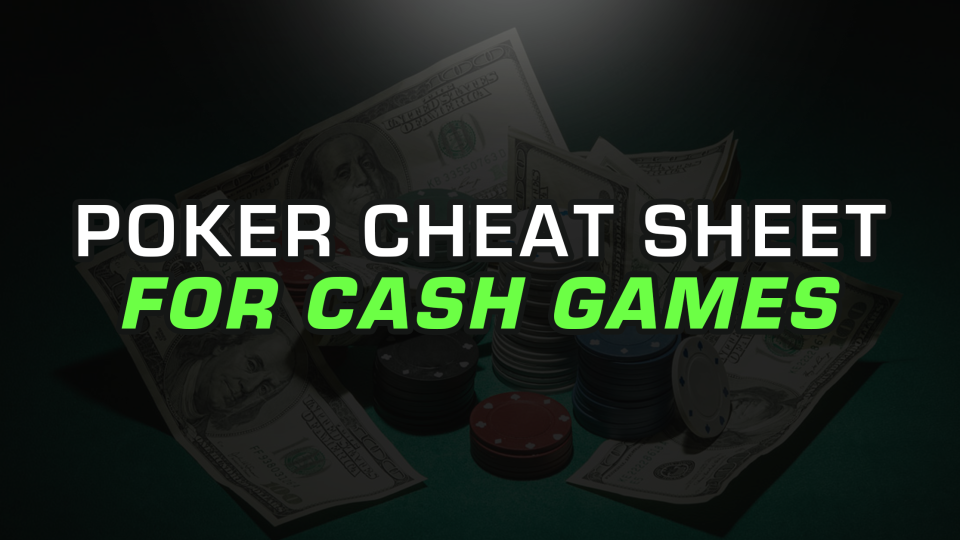
Cash games are significantly different from tournaments, and there are many areas to focus on in cash games that don’t exist in tournament poker.
Our cash game poker cheat sheet is designed to help novice and intermediate cash game players get to the next level and keep their game sharp throughout their cash game sessions.
If you are just starting to learn cash game strategy or are struggling to win, download our cash game cheat sheet and use it for a quick reminder of the key things you should focus on.
Be Ready for Your Cash Game
Going into a cash game session actually ready to play is a big part of what it takes to consistently win in them.
Bankroll management is a critical part of the game, as playing without a proper bankroll will often lead to playing sub-optimal poker.
Even if you do have an appropriate bankroll, your mindset can be a big obstacle in becoming a winner in cash games.
The biggest cash game winners focus on playing every spot optimally and are never afraid to make the right play, whether it’s a big all-in push on the river or a tight fold that seems too crazy to make.
Before you can make the right plays in-game, you will need to be well-rested, well-fed, and completely focused on the game and what’s happening at the tables.
Laser Focus on Your Opponents
One of the biggest pitfalls of cash game players is that they start playing the game robotically and do not truly make decisions when they play.
If you play this way and don’t focus on your opponents, you may be a slight winner, but you will never be a real crusher with a massive win rate.
To beat cash games for the maximum, you will need to focus on every hand, get specific reads on your opponents, and figure out strategies that best exploit their leaks.
The only way to do this is to be 100% focused on the game you are playing in and the players you are playing against every time you are playing a cash game.
Take Your Game to the Next Level
There is a lot of room for growth in the cash game streets, but the only way to keep advancing to higher levels is to keep improving your game.
A cash game player’s work does not end when they stop playing but instead extends well beyond actual gameplay.
The time between sessions should be spent on studying cash game poker, improving the weakest aspects of your game, and discussing your hands with other players.
While studying is not as fun and exciting as playing, the time you spend in the lab will translate into a higher win rate and more profit in the long run.
Download our cash game poker cheat sheet for a short but detailed resource you can use on the go and consult every day to remind yourself of all the things you need to do to optimize your results in cash game poker.
Summary – Why You Should Use Poker Cheat Sheets
Studying poker with the help of our coaching materials and tools is a guaranteed way to take your game to the next level, but our poker cheat sheets are handy tools that you can use to quickly remind yourself of the key aspects to keep in mind when playing.
Whether you are playing tournaments or cash games, poker cheat sheets will help keep your mental game sharp and maintain your focus on the important things in-game.
Download our tournament and cash game poker cheat sheets and consult them before every session you play.
FAQ
What are poker cheat sheets?
Poker cheat sheets are useful documents with quick and on-point tips designed to help players remember the most important things about their strategy very fast. Poker cheat sheets can contain hand ranges, strategic tips, bet sizing, and other useful information.
Why should I use poker cheat sheets?
Using poker cheat sheets is a great way to quickly remind yourself of the key strategies you should apply in your game. Unlike other coaching materials, poker cheat sheets take a much shorter time to look at and use, which makes them an invaluable tool.
Can I use poker cheat sheets while playing?
While many poker rooms will allow you to use poker cheat sheets while playing, we recommend only consulting your cheat sheets during breaks or when away from the tables. When playing online poker, consult your cheat sheets before and after sessions, but don’t use them while playing, as using them may be considered cheating by some poker sites.
How can poker cheat sheets help me improve my game?
Poker cheat sheets can quickly point you to the biggest flaws in your game and even help you correct your mistakes in just seconds. The tips provided in our poker cheat sheets will help you establish and maintain a winning poker strategy and mentality.
What is the difference between tournament and cash game cheat sheets?
Our tournament and cash game poker cheat sheets provide different advice and tips depending on the game in question. The two games are very different, and the tips provided in the cheat sheets reflect those differences and focus on key strategies you should be applying in the particular games.
